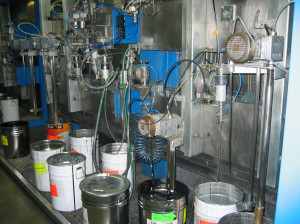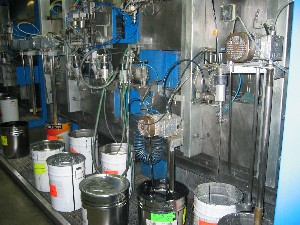A 200 l metal drum containing paint cabin cleaning solvents exploded at 7 pm in a factory applying paints and varnishes to plastic parts for the automobile industry. 8 employees were injured, included 3 seriously injured and 12 others were shocked at seeing their colleagues burned. One employee, who suffered 80% burns died on 19/01, then a second employee died 3 days later. The drum, on duckboards and earthed, which contained 50% methyl ethyl ketone (MEK) and 50 % butyl acetate, shot up vertically hitting the ceiling. Staff contained the fire that followed the explosion. Damages were limited to 100 m² of workshop. Around one hundred fire fighters, medical teams and gendarmes (French military police) arrived on site. The fire extinguishing water was collected. A legal expert was appointed and the line affected by the explosion was sealed.
The Inspection of classified installations carried out an in-depth inspection 5 days later. A complementary prefectural order was proposed to the Prefect. The operator had to supply an accident report. The line not affected resumed operation on 18/01 but without the drums, with the flushing solvents collected by the paint cabin water curtains.
The most likely scenario was the following: an air/solvent explosive atmosphere was present in the drum vapour and inside the filling rod. The residual electrostatic charge of the spraying bowl was transferred to the solvent (charge dissipation time of 7 s announced by the supplier, longer than the solvent dispatch time). The solvent kept its charge when passing through the pipe connecting the bowl to the filling rod (insulating pipe) and caused a spark on contact with the metallic end of the rod. This caused the gaseous vapour in the rod and drum to ignite and the air/solvent mixture to explode.
Restarting of the affected line was dependent on providing an assessment containing a specific study on the electrostatic risks of the line in its future configuration. This study had to be carried out by a body recognised for its expertise in the field of static electricity. The assessment had to include the recommendations formulated by the expert on 18/01: ventilation of the spray robot, fire detection systems in the spray cabins, sealing of the robot’s electrical cableways, estimation of the maximum energy released by the robot, shutdown of the flushing system and solvent recovery in the drums pending the findings of the assessment. On 25/08, a fire had already occurred on site (ARIA 30491).
The use of electrostatic guns and bowls in the cabins started up in 2004, gradually replaced the conventional method. This was accompanied with modifications including optimisation of the volumes of paint used and an increase in colour changing rates. The latest adjustments took place at the end of December for restart of the line on 3/01. The operator did not carry out any risk analysis.
Following this accident, apart from the recommendations formulated by the expert on 18/01, the operator took several measures: equipment earthing was checked once a month by the company and once a year by an external body; guns and bowls were supplied with solvent when they are potentially at zero; modifications were planned on the solvent feeder circuits; the technicians were equipped for effective earthing; the areas were listed and identified based on their risk and a plan was kept up-to-date by the operator, and the equipment available in high-risk explosion areas were brought into compliance with the ATEX Directive.
The line was restarted on 12/09. Operating losses were between 4.8 and 8 million euros.
Download the detailed report in .pdf format (1.2 Mb)





